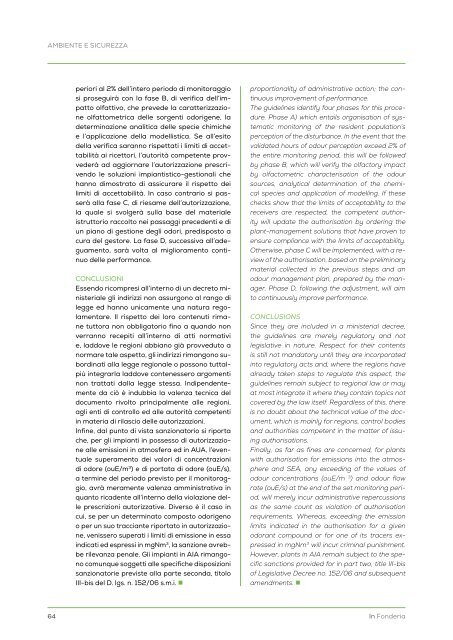In Fonderia 1 2024
Primo numero del 2024 di In Fonderia
Primo numero del 2024 di In Fonderia
You also want an ePaper? Increase the reach of your titles
YUMPU automatically turns print PDFs into web optimized ePapers that Google loves.
AMBIENTE E SICUREZZA<br />
periori al 2% dell’intero periodo di monitoraggio<br />
si proseguirà con la fase B, di verifica dell’impatto<br />
olfattivo, che prevede la caratterizzazione<br />
olfattometrica delle sorgenti odorigene, la<br />
determinazione analitica delle specie chimiche<br />
e l’applicazione della modellistica. Se all’esito<br />
della verifica saranno rispettati i limiti di accettabilità<br />
ai ricettori, l’autorità competente provvederà<br />
ad aggiornare l’autorizzazione prescrivendo<br />
le soluzioni impiantistico-gestionali che<br />
hanno dimostrato di assicurare il rispetto dei<br />
limiti di accettabilità. <strong>In</strong> caso contrario si passerà<br />
alla fase C, di riesame dell’autorizzazione,<br />
la quale si svolgerà sulla base del materiale<br />
istruttorio raccolto nei passaggi precedenti e di<br />
un piano di gestione degli odori, predisposto a<br />
cura del gestore. La fase D, successiva all’adeguamento,<br />
sarà volta al miglioramento continuo<br />
delle performance.<br />
CONCLUSIONI<br />
Essendo ricompresi all’interno di un decreto ministeriale<br />
gli indirizzi non assurgono al rango di<br />
legge ed hanno unicamente una natura regolamentare.<br />
Il rispetto dei loro contenuti rimane<br />
tuttora non obbligatorio fino a quando non<br />
verranno recepiti all’interno di atti normativi<br />
e, laddove le regioni abbiano già provveduto a<br />
normare tale aspetto, gli indirizzi rimangono subordinati<br />
alla legge regionale o possono tuttalpiù<br />
integrarla laddove contenessero argomenti<br />
non trattati dalla legge stessa. <strong>In</strong>dipendentemente<br />
da ciò è indubbia la valenza tecnica del<br />
documento rivolto principalmente alle regioni,<br />
agli enti di controllo ed alle autorità competenti<br />
in materia di rilascio delle autorizzazioni.<br />
<strong>In</strong>fine, dal punto di vista sanzionatorio si riporta<br />
che, per gli impianti in possesso di autorizzazione<br />
alle emissioni in atmosfera ed in AUA, l’eventuale<br />
superamento dei valori di concentrazioni<br />
di odore (ouE/m 3 ) e di portata di odore (ouE/s),<br />
a termine del periodo previsto per il monitoraggio,<br />
avrà meramente valenza amministrativa in<br />
quanto ricadente all’interno della violazione delle<br />
prescrizioni autorizzative. Diverso è il caso in<br />
cui, se per un determinato composto odorigeno<br />
o per un suo tracciante riportato in autorizzazione,<br />
venissero superati i limiti di emissione in essa<br />
indicati ed espressi in mgNm 3 , la sanzione avrebbe<br />
rilevanza penale. Gli impianti in AIA rimangono<br />
comunque soggetti alle specifiche disposizioni<br />
sanzionatorie previste alla parte seconda, titolo<br />
III-bis del D. lgs. n. 152/06 s.m.i. •<br />
proportionality of administrative action; the continuous<br />
improvement of performance.<br />
The guidelines identify four phases for this procedure.<br />
Phase A) which entails organisation of systematic<br />
monitoring of the resident population’s<br />
perception of the disturbance. <strong>In</strong> the event that the<br />
validated hours of odour perception exceed 2% of<br />
the entire monitoring period, this will be followed<br />
by phase B, which will verify the olfactory impact<br />
by olfactometric characterisation of the odour<br />
sources, analytical determination of the chemical<br />
species and application of modelling. If these<br />
checks show that the limits of acceptability to the<br />
receivers are respected, the competent authority<br />
will update the authorisation by ordering the<br />
plant-management solutions that have proven to<br />
ensure compliance with the limits of acceptability.<br />
Otherwise, phase C will be implemented, with a review<br />
of the authorisation, based on the preliminary<br />
material collected in the previous steps and an<br />
odour management plan, prepared by the manager.<br />
Phase D, following the adjustment, will aim<br />
to continuously improve performance.<br />
CONCLUSIONS<br />
Since they are included in a ministerial decree,<br />
the guidelines are merely regulatory and not<br />
legislative in nature. Respect for their contents<br />
is still not mandatory until they are incorporated<br />
into regulatory acts and, where the regions have<br />
already taken steps to regulate this aspect, the<br />
guidelines remain subject to regional law or may<br />
at most integrate it where they contain topics not<br />
covered by the law itself. Regardless of this, there<br />
is no doubt about the technical value of the document,<br />
which is mainly for regions, control bodies<br />
and authorities competent in the matter of issuing<br />
authorisations.<br />
Finally, as far as fines are concerned, for plants<br />
with authorisation for emissions into the atmosphere<br />
and SEA, any exceeding of the values of<br />
odour concentrations (ouE/m 3 ) and odour flow<br />
rate (ouE/s) at the end of the set monitoring period,<br />
will merely incur administrative repercussions<br />
as the same count as violation of authorisation<br />
requirements. Whereas, exceeding the emission<br />
limits indicated in the authorisation for a given<br />
odorant compound or for one of its tracers expressed<br />
in mgNm 3 will incur criminal punishment.<br />
However, plants in AIA remain subject to the specific<br />
sanctions provided for in part two, title III-bis<br />
of Legislative Decree no. 152/06 and subsequent<br />
amendments. •<br />
64<br />
<strong>In</strong> <strong>Fonderia</strong>














